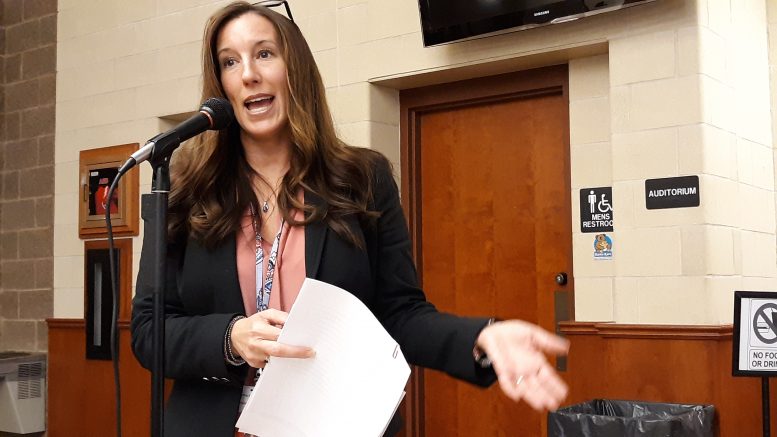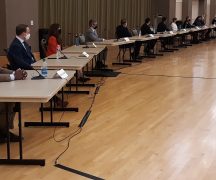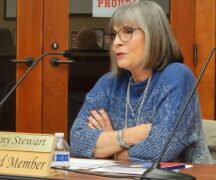By JAN LARSON McLAUGHLIN
BG Independent News
It’s not the stars – but dollar signs – that seem to be in alignment for Bowling Green City Schools. If all the pieces fall in place, the high school renovations may be possible without asking voters for more money, according to Treasurer Cathy Schuller.
Here are the numbers …
On the savings side, Schuller reported to the school board Tuesday evening that low interest rates could result in a savings of $13 million over the 30 years of the school bond issue.
And on the revenue side, she presented the latest pipeline tax information, which shows Bowling Green getting about $3 million more a year from the second Rover pipeline.
(A second story from the school board meeting on the upcoming levy will appear later Wednesday.)
If voters pass the school issue in November, low interest rates and high pipeline tax revenue may be enough to potentially fund a high school renovation project without additional costs to the taxpayers, Schuller said.
But both bits of good news come with a caveat.
The low interest rate will only benefit the district if voters approve the building project and the district can take advantage of the savings. Plus, “one tweet can change everything,” Schuller said.
And the pipeline revenue report again came with cautionary language from the Wood County Auditor reminding the district that the pipeline company can appeal its tax value.
Schuller started with charts showing the interest rate dropping from 4.25 percent last year when the ballot language estimate was made, to 3.01 percent in August. That was enough to create a $10 million savings for the district over 30 years. The rate continued to drop to 2.62 percent earlier this month, and then further down to 2.59 percent in the last few days. That would bring an additional savings of $3 million, Schuller said.
“If we locked it in now, we’d be looking at saving $13 million,” she said.
That means the district will have some options if voters pass the 1.6-mill bond/0.25 percent income tax in November.
For example, Schuller said, the board could reduce the term of bond financing from 30 years to 20 or 24 years. Or the board could collect a lower tax on the bond.
Since the income tax can only be collected in one-quarter increments, the board cannot lower the percentage. But the board could reduce the term of the financing or apply additional funds toward the principal payment.
Schuller stressed that the best time to finance any facility project is when interest rates are so low.
As for the pipeline tax revenue, Schuller said it looks like starting next year the school district will get about $2.9 million a year in additional funding from the second Rover pipeline that runs through the district.
The district received $758,000 earlier this year for the first Rover pipeline to go into operation.
“This is excellent news for the district,” Schuller said of the projected revenue.
The pipeline company has until midnight on Dec. 6 to file an objection to the tax values. Its payments depreciate each year, and it pays no taxes if the line is not in operation.
The board previously voted to put all pipeline tax revenue toward capital projects. Some of the options for using the additional funds could include:
- Pay off existing debt, such as for the middle school, which has a current balance of nearly $4 million.
- Pay toward the bonds from a 2007 project, with a current balance of $21.3 million.
- Subsidize the payment on the new bonds and lease purchase of the new elementary.
- Use the money to help with the renovation of the high school.
But Schuller cautioned the board about the uncertainties. First, a change in state law is being considered that would lower the tax rate on public utility property. Also, the state has the ability to change the funding formula to reduce the state aid to districts that get pipeline revenue. And the pipeline company is subject to bankruptcy, like any private company.
Also at the meeting, Superintendent Francis Scruci reported that the district had received a donation from a Bowling Green industry, Lubrizol, of $18,000 worth of virtual reality headsets. Scruci thanked Lubrizol and said students will now be able to travel the world without leaving school.
Scruci also said the district received a safety grant of $16,600 from the Ohio Attorney General’s Office. The grant is being used for “Raptor” technology, which scans the photo identifications of all school visitors to determine if they have criminal histories or other issues the school should be aware of. The system then prints up a photo badge for the person to wear while visiting the school.
Also being purchased with the grant funds are “Stop the Bleed” stations that are attached to the walls in all the schools. “We hope to never have to use it,” but they are available in case they are needed, Scruci said.
Scruci also talked about the recent loss of a student, who took his own life. “It shook our school community,” he said. Scruci thanked Children’s Resource Center counselors and Otsego for sending its therapy dog to help with the grieving process.
At the recent candidate’s night, when answering a question about the incident and school needs, one candidate implied the district needed to reach out more to area services that are available.
“I take offense to that,” Scruci said. He then read a long list of all the partnerships the school district has with programs such as Help Me Grow; CRC; Wood County Alcohol, Drug Addiction and Mental Health Services Board; Wood County Educational Service Center; Family First Council; Children’s Services; Wood County Health Department; Bowling Green Police Department; Wood County Sheriff’s Office; and Wood County Juvenile Court.
“This is just a partial list,” he said.
All the district’s counselors are trained for crisis intervention. Students and teachers are taught how to spot and report possible problems with students.





